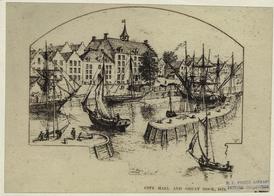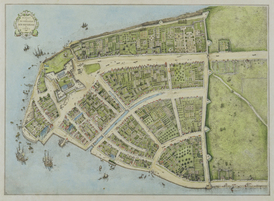Gideon and the Great Dock
On an August day in 1664, the Dutch ship Gideon reached the Great Dock in New Amsterdam. Its long journey had begun in the Netherlands, where it took on board wrist and ankle shackles, and other supplies for its mission. Its first stop was Angola, Africa, where the captain was directed to “as quickly as possible, take on board as many slaves as he can conveniently transport,” along with copper and elephant tusks. The ship then crossed the ocean to the Caribbean, where it delivered slaves and the other “cargo,” before proceeding to New Amsterdam. It arrived at the Great Dock with 291 Africans. To date, this was the largest shipment of enslaved men, women, and children to the Dutch colony. The Dutch West India Company relied on Africans to build homes, fortifications, and even the Great Dock. It was Africans who unloaded the Gideon.
Before the Gideon could be loaded again, British warships arrived. Without a single shot being fired, New Amsterdam became New York, and about 150 Dutch soldiers marched onto the Gideon to sail home.
The English took possession of a town with a population of about 1,500 whites, 300 slaves, and 75 freedmen. The largest slave owner was the Dutch West India Company, which had granted some of the older Africans a kind of half-freedom and plots of land. The Land of the Blacks was a group of 8-to-12-acre farms north of the town. The English were quick to question the freedom of these blacks and their landholdings. As difficult as life was for the Africans under the Dutch, it was about to get harsher.
This entry contributed by
Curriculum Concepts International
Related Media
Images

|
In 1659, when Africans built the Great Dock, Pearl Street was the water’s edge. The dock was located between today’s Whitehall Street and Broad Street, which was a canal.
|

|
This depiction of City Hall and the Great Dock is from 1679.
|

|
The Gideon, carrying 291 enslaved Africans, arrived at the Great Dock in 1664. Africans did most of the labor needed by the Dutch West India Company in New Amsterdam.
|

